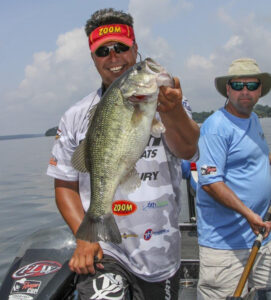The water tumbles, tripping over itself in a foamy turbulence that disorients baitfish and gathers opportunistic predators in great numbers. Indeed, a dam’s downstream outflow – the tailrace – can be a bass fishing day-saver.
Hydro-electric power generation, flood control, irrigation and municipal water supplies – these may be the stated purposes for the structures that control some of the nation’s major rivers; but the unintentional benefit of bass aggregation is a bonus gladly accepted by those with toes on a trolling motor pedal.
WHY TO TARGET TAILRACES
“It’s the door to the refrigerator, but it only works if the light is on – it’s hard to find something in the refrigerator if it’s dark,” said FLW Tour pro Wesley Strader. “The current is the light, and if there’s no current running, it’s dark. But if the current’s running, you’re good to go.”
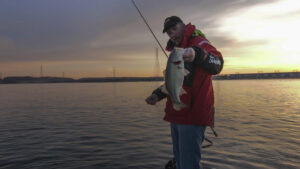
Pickwick Lake guide Jimmy Mason points out that the current also serves as an aerator. And, highly oxygenated is generally cooler.
“Depending on the time of year, it can be 5-10 degrees cooler,” Mason said. “But in the summer, it can be 15 degrees cooler.”
Conversely, winter usually finds tailrace water much warmer than the downstream water. Cold water picks up a few degrees of warmth as it traverses the turbines which can make a big difference to shivering bass.
From a tournament angler’s perspective, Mason offers these observations:
“In the summer, higher oxygen content draws in the baitfish and the bass,” he said. “A dam’s tailrace is loaded with baitfish, so the fish are fatter. In a tournament, bass of equal length will generally be heavier in the tailrace.
“Also, in summer tournaments, it’s common to fish either deeper offshore structure or a tailrace. When you catch them in the tailrace you don’t deal with the bends and other decompression issues, so the fish live longer in livewells.”
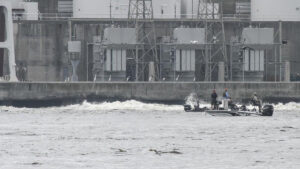
WHAT TO THROW
As conditions allow, Strader prefers cranking the rocky edges with a PH Custom Lures signature series old school balsa flat-sided bait in Louisiana shad or sexy shad.
“When you can see the bait against the bank and they’re running the water really hard, that’s my go-to bait,” he said.
As much as he hates to admit it, Strader said he occasionally turns to an Alabama Rig or similar castable umbrella rig if sees the fish keying on balls of bait that the current has stacked near the bank. However, when the forage is a little more dispersed, he’ll follow up his crankbait with a Texas-rigged tube.
“I really like flipping a Zoom tube to the rocks,” Strader said. “I’ll rig it on a 4/0 Trokar EWG hook with a 3/8-ounce Reins tungsten weight. If the fish are not really on a minnow bite and I’m not catching many on the crankbait, I’ll go back down the bank again with that tube and pitch it to current breaks.
“I like pitching up-current of a break and letting the tube flow past whatever’s breaking the current. But if the water’s moving too fast, I’ll just pitch the tube to the eddies.”
For the summer months, Strader likes a black neon tube in dingy water or root beer when algae blooms give the water a greenish tint.
Mason always keeps a Zara Spook Jr. or a Super Spook ready for a dynamic opportunity. Bass are usually super active and aggressive in a flowing tailrace, but Mason looks for a particular topwater setup where he can tempt fish sitting in slack water ambush spots.
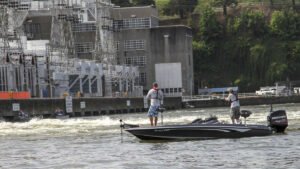
FISH CURRENT LIKE A PRO
“Look down the outside seam line where the current is hitting a bar,” he said. “You’ll see little points of current coming off the main current. Treat those current points just like a point of land.”
As Mason explains, bass will form wolf packs that push those shad along the edge. When one flares out from a point, eager jaws are quick to capitalize.
“I use that spook and try to hit exactly where they break,” Mason said. “I tell myself I want to knock that shad out of the way and take that attention away from it.”
For the mid water column, Mason leverages the current’s momentum with a ½- to ¾-ounce jighead Super Glued to a YUM Money Minnow. In clear water, he likes Foxy Shad, while black back pearl or Hologram shad work best in super high clarity.
“The rhythm is important,” Mason explains. “You only want to touch bottom two to three times. If you’re continuously bumping you’re going to hang up.”
For bottom presentations, Mason will toss a 1/2-ounce Booyah jig (black/blue or green pumpkin) and YUM Mighty Craw Chunk toward the ripples of specific rocks.
Given the often sporty current flow, long casts with a subsurface bait can leave a big bow in the line. Mason remedies this with a 7-foot, 4-inch Lew’s heavy-power rod with a Lew’s BB1 Pro 6.4:1 reel carrying 17-pound fluorocarbon line. The beefy outfit, he said helps him quickly gather line for a solid hook set.
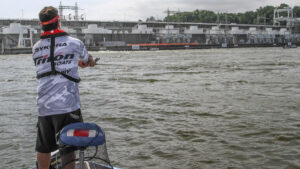
DOWNSTREAM HOT SPOTS
Despite the natural tendency for boats to cluster near the source of a tailrace flow, the presence of random bars, rock piles and other downstream current deflectors buoys the wisdom of searching beyond the obvious. Just ask Missouri pro Marcus Sykora who dominated the 2014 BFL All-American on Wilson Lake after locating a long, narrow tailrace bar with a particular little bend the fish were digging.
Deep diving crankbaits kept him busy for the better part of three days, while big worms on shaky heads and football heads worked well off the back of the boat.
The clear upside of an active tailrace bite is the potential for fast-paced action that can keep an angler busy, if not somewhat distracted. Remember, though, highly focused current, plus lots of boats, plus sneaky rocks that often hide mere inches below the surface can equal disaster.
When the water’s steaming, the birds are screeching and diving, guys are hooking up left and right – it’s easy to lose focus and end up on a collision course with rock on fiberglass and little time for evasive action. Maintain situational awareness and stay ready for that next big bite.
EDITOR’s NOTE: Keep in mind that many states require PFD’s while fishing in tailrace areas. We think it’s a good idea on any tailrace regardless of the specific state laws.
